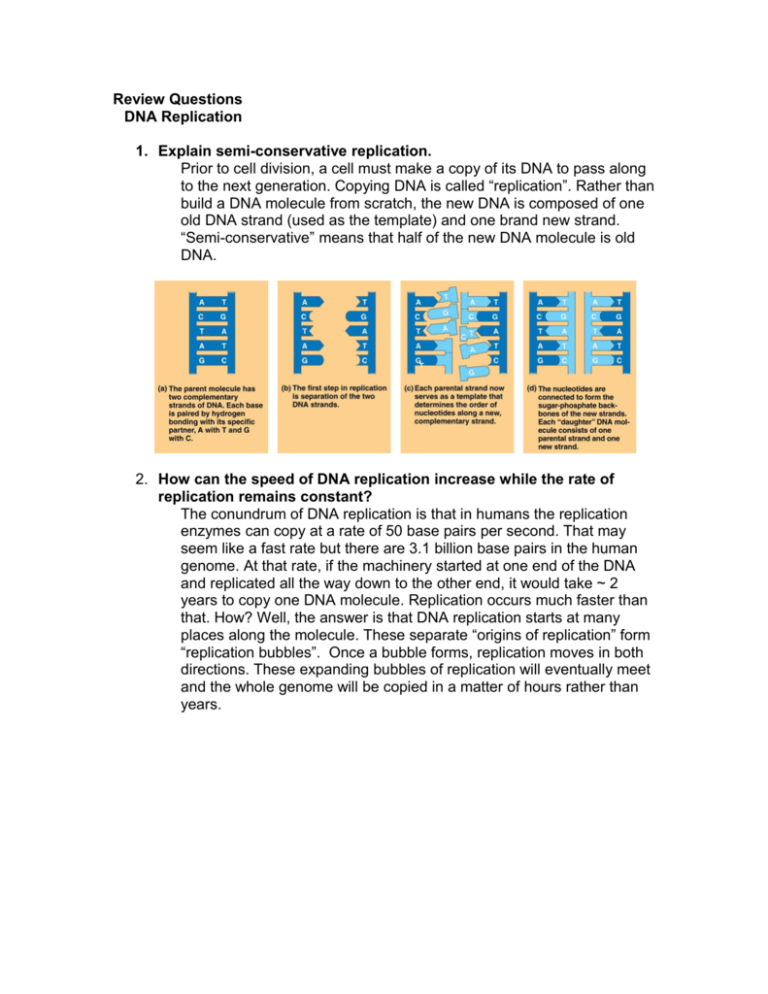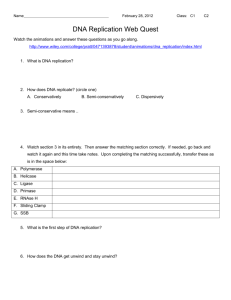Review Questions
advertisement

Review Questions DNA Replication 1. Explain semi-conservative replication. Prior to cell division, a cell must make a copy of its DNA to pass along to the next generation. Copying DNA is called “replication”. Rather than build a DNA molecule from scratch, the new DNA is composed of one old DNA strand (used as the template) and one brand new strand. “Semi-conservative” means that half of the new DNA molecule is old DNA. 2. How can the speed of DNA replication increase while the rate of replication remains constant? The conundrum of DNA replication is that in humans the replication enzymes can copy at a rate of 50 base pairs per second. That may seem like a fast rate but there are 3.1 billion base pairs in the human genome. At that rate, if the machinery started at one end of the DNA and replicated all the way down to the other end, it would take ~ 2 years to copy one DNA molecule. Replication occurs much faster than that. How? Well, the answer is that DNA replication starts at many places along the molecule. These separate “origins of replication” form “replication bubbles”. Once a bubble forms, replication moves in both directions. These expanding bubbles of replication will eventually meet and the whole genome will be copied in a matter of hours rather than years. 3. Explain the process of DNA replication. Unwinding and Unzipping the Double Helix. The two strands in a DNA molecule are connected by hydrogen bonds between the complementary bases. An enzyme called “helicase” travels along the DNA unwinding and breaking the hydrogen bonds between the two strands. An enzyme called “topoisomerase” travels just ahead of helicase on the replication fork to prevent the DNA from winding too tight. Once the DNA strands are separated, “single strand binding proteins” hold the strands in place so they can be replicated efficiently. Replicating the Leading Strand. The leading strand is built by using the lagging strand of the old molecule as the template. Replication of the leading strand begins with the enzyme “primase”. Primase adds a small complementary piece of RNA (~10 nucleotides), called an “RNA primer”, near the end of the lagging strand. The RNA primer gives an enzyme called “DNA polymerase III” something to attach a DNA nucleotide to. A jury-rigged design, RNA primers are necessary because DNA polymerase III can only attach nucleotides to the 3’ end of a pre-existing nucleotide. At the start of a DNA molecule there is no pre-existing nucleotide, so DNA polymerase III can’t work. Another limitation is that DNA polymerase III can only build a strand in the 5’ → 3’ direction. Luckily, in building the lagging strand, the DNA polymerase III builds the leading strand in the direction of the replication fork (5’→ 3’) The RNA primer is eventually replaced by DNA by another enzyme “DNA polymerase I”. Replicating the Lagging Strand. Replication of the lagging strand is a bit more complicated. Just like the replication of the leading strand, primase first has to install an RNA primer. DNA polymerase III, as expected, builds the new strand in the 5’ → 3’ direction. However, since the template strand of the lagging strand is anti-parallel to the template strand of the leading strand, DNA polymerase III builds the strand away from the replication fork. Another jury-rigged design. To solve this problem, the lagging strand is built in a series of short segments known as Okazaki fragments (1,000 to 2,000 bases). And even though individual fragments are built in a direction away from the replication, each new one starts closer to the fork. “One step forward, two steps back.” The details are as follows: (1) primase installs an RNA primer. (2) DNA polymerase III attaches a nucleotide to the 3’ end of the last RNA nucleotide in the primer and begins building the strand in the 5’-3’ direction (away from the fork). (3) After building an Okazaki fragment of 1000 to 2000 bases, DNA polymerase III stops. (4) DNA polymerase I replaces the RNA primer with DNA. (5) Primase backs up and installs a new primer one Okazaki fragment closer to the replication fork. (6) DNA polymerase III attaches the first nucleotide of the Okazaki fragment to the RNA primer and then builds the fragment. (7) DNA polymerase I replaces the RNA primer. (8) Ligase, another enzyme, connects the two new Okazaki fragments together. 4. Explain how DNA erosion occurs and how it is prevented. In the replication of the leading strand, primase installs an RNA primer at the beginning of the DNA molecule. DNA polymerase I removes and, in fact, does not replace the RNA primer. As a result, the new DNA molecule is going to be a tad shorter. Each time the DNA replicates, it gets shorter and shorter until the erosion removes an important gene and the cell dies. A typical cell can usually divide a maximum of about 50 times before croaking. 5. What about stem cells? They aren’t limited to 50 divisions. Stem cells can divide indefinitely. What makes a stem cell impervious to erosion? The answer is the enzyme telomerase. After each replication, telomerase adds extra bits of DNA onto the ends of the strands (known as telomeres) to offset the loss from erosion.






